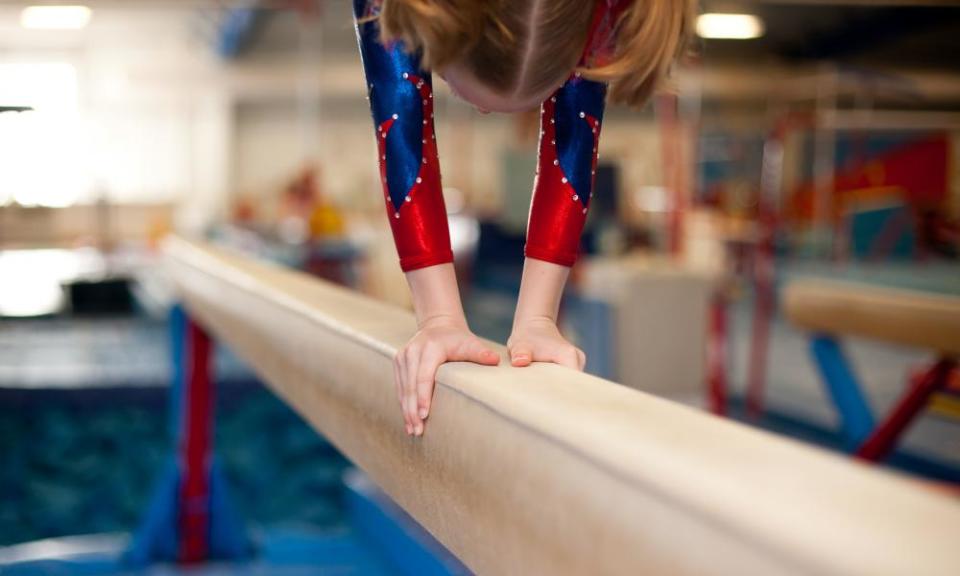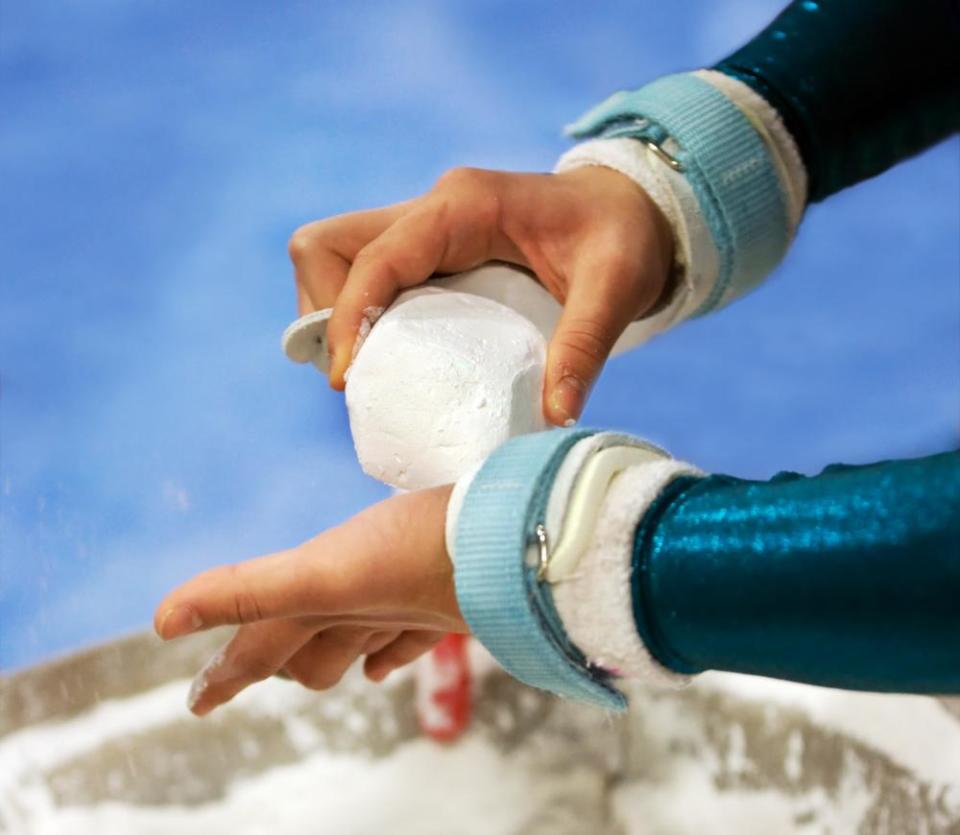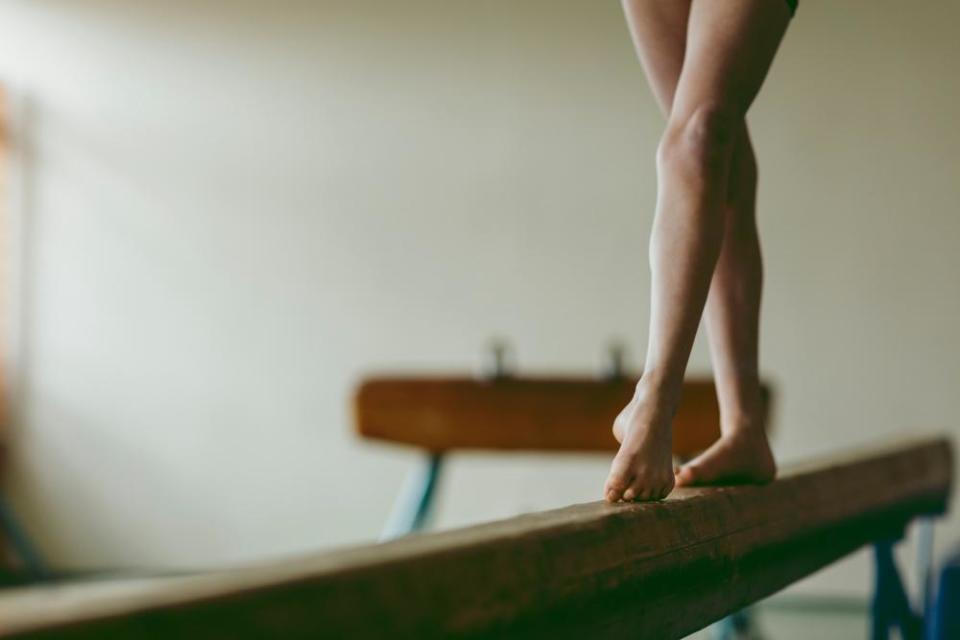‘Petri dish for abuse’: gymnastics faces a reckoning in Australia

The gymnasts sit cross-legged on the mat. Some in activewear crop tops, others in leotards with shimmery fabric and diamantes. Water bottles adorned with butterflies and rainbows are tossed at the mat’s edge by the wall.
For over two hours at a small gymnastics centre in Sydney, they do lunges across a spring floor, backbends, kickovers. They spin themselves over the lower of the two parallel bars, pull themselves up and then spin backwards over it. They spot each other in handstands against the wall. And at the end of the second hour, they finish with muscle conditioning. Sit-ups. Push-ups. Planks. The muscles in their calves and thighs are defined. Those in crop tops have visible abdominal muscles. They are six, seven and eight-year-old girls.
Related: Australian gymnastics ‘a high-risk environment for abuse’, review finds
Gymnastics is a popular sport in Australia. Some 11% of children who play sport do gymnastics, which trails only swimming and football by participation rates.
Gymnastics is also facing a reckoning. On Monday the Australian Human Rights Commission released its report into abuse allegations within the sport in Australia. The inquiry was launched at the request of Gymnastics Australia after gymnasts in Australia, alongside others the world over, revealed their own traumatic experiences of the sport following the release of the documentary Athlete A. Many reports resulted in dramatic findings, including a Dutch inquiry that determined that gymnastics in that country constituted legalised child abuse.
In its own findings on Monday, the AHRC identified certain risk factors that made the sport ripe for abusing those within it: a culture of win-at-all-costs, an environment of control, a tolerance of poor behaviour and the young age of female gymnasts.
Child’s work
Speaking to the Guardian last year, Adair Donaldson, a lawyer representing dozens of gymnasts and their families before the inquiry, said, “It’s the age issue that gets us.”
“We’re talking about children who are eight, 10, years of age and they’re competing internationally. You’re thinking: ‘Geez, how does this happen?’”
The average age of someone doing gymnastics in Australia is eight. Only 9% of people participating in gymnastics are over the age of 12. Many clubs run recreational programs from toddler age and from an early age girls who show desirable characteristics are invited to join competitive women’s artistic gymnastics squads within the clubs, separate from the play-based sessions of their peers. It is typical for this lowest, entry-level stage to involve four hours of training a week.
Young girls are socialised to follow instructions, be docile and complaint
Dr Georgia Cervin
“Not only are the girls recruited into competitive gymnastics at a really young age, at about five usually, but their training hours go up really quickly,” says Dr Georgia Cervin, a historian researching women’s artistic gymnastics at the University of Western Australia. “It’s not uncommon for girls under 10 to be doing upwards of 20 hours a week. That’s where it’s quite different from other sports.”
“I’ve never seen a club that doesn’t ask its gymnasts to start early,” says associate professor Natalie Barker-Ruchti of Örebro University, a leading scholar in women’s gymnastics.
“The idea that you need to start early is one of the most deep-seated beliefs in women’s artistic gymnastics. It’s assumed to be basically the only way to do the sport.”
In Gymnastics Australia’s 2018 high performance plan to improve Australia’s elite gymnastics performance by the 2028 Olympic Games, the organisation says: “It is recognised that from an early age, gymnasts must be exposed to a comprehensive array of technical development, to ensure they have the fundamental building blocks for future high performance success.” The foundation blocks for elite performance, it says, are laid between the ages of six and eight.
Many other sports have begun to move away from early specialisation, and avoid intensive training until children enter adolescence, says Prof John Cairney, head of the School of Human Movement and Nutrition Sciences at the University of Queensland.
“Gymnastics has generally been the anomaly because there is a belief among some people that there are certain skills which, if you don’t develop them very, very early in life, you won’t develop,” he says. “But there isn’t really good data to allow scientific consensus on that, and that’s why in some ways it’s facilitated gymnastics and other sports to make their own claims.”
From women to girls
Gymnastics has not always been the domain of children. Cervin, herself an ex-elite gymnast who competed internationally for New Zealand, is the author of Degrees of Difficulty: How Women’s Gymnastics Rose to Prominence and Fell from Grace (publishing this June). In the early 20th century, gymnastics sought to present itself as a sport uniquely suited to women, a sport that emphasised “harmonious flexibility and feminine grace”. In the 1960s, most women competing were in their 20s and 30s.
In the 1960s and 1970s it all changed. The introduction of the amateur rule meant adults struggled to do sports and earn a living. Girls, however, could spend all their time training. Coaching became professionalised, and rules banning men from coaching women were lifted. Male coaches preferred working with girls than women, Cervin says, because their bodies were more similar to the boys and men they were used to working with.
We were groomed and we were basically just lucky that nothing bad happened to us
Dr Georgia Cervin
“They also found that young girls are socialised to follow instructions, be docile and complaint,” she says. “The ability to control these girls makes these coaches’ jobs much easier.”
These male coaches began teaching the girls acrobatic and strength skills previously only seen in men’s gymnastics. The sport required more muscular bodies, and greater risk, which gymnasts tried to offset by performing cuteness; adding glitter to their costumes and hair, smiling at judges and performing choreography that mimicked child’s play.
When Romanian Nadia Comăneci entered the world stage, blitzing the Olympic field and becoming the first gymnast to earn a perfect score, she was 14. “Over the years, women’s gymnastics has cemented this understanding that children are best at it,” says Cervin.

‘I see it as child cruelty’
Every gymnast in the world has been rocked by revelations in the documentary Athlete A about the abuse of young girls by USA Gymnastics team doctor Larry Nassar, says Cervin. “I think everyone has asked themselves: if this was happening in my country would it have happened to me? And I think everyone has come to the answer: ‘Yeah, it would.’
“We were groomed and we were basically just lucky that nothing bad happened to us. Because gymnasts are told to be quiet, not question anyone or anything, do what you’re told no matter how hungry or tired or hurt you are. And if you don’t, you’ll be ignored, and isolated, and left out.”
Gymnasts’ lawyer Donaldson says that amid a win-at-all-costs culture, young girls in Australian gymnastics have been subject to extreme expectations about weight loss and their physical performance. Girls as young as eight, nine or 10 were subject to “constant skin fold tests” to measure body fat, and extreme expectations about weight loss. Some allege long-term physical injuries due to being forced to train while injured, many others allege ongoing psychological impacts such as eating disorders as a result of their experience in childhood.
Imagine if we were treating racehorses or greyhounds like this – there’d be public uproar
Lawyer Adair Donaldson
“I look at some of the allegations … and I see it, I suppose, as child cruelty,” he says. “Imagine if we were treating racehorses or greyhounds like this – there’d be public uproar. And yet coaches, what they put these young girls through, I think, is extraordinary.”
The girls’ agency, he says, is removed in their training environments; their ability to complain restricted, their access to parents limited. “They were told: you don’t cry, you don’t complain, you don’t question the coaches – you just do it. If you think about that, that creates the perfect petri dish for abuse to occur.”
Cervin says that for some children, spending hours and hours training in the gym is like a dream come true. But the recent outcry from gymnasts globally indicates it was not a dream for all. For others engaged in intense training at a prepubescent age, there were many challenges. The need to reduce body fat as they enter puberty can lead to “extreme measures” to delay the development of more womanly bodies. Overtraining and injuries can have lasting impacts on bodies that are still growing.
But, she says, one of the biggest problems is socialisation. Children training at the rates required in elite and pre-elite programs can miss out on other sports, social events and schooling essential to their broader development. That investment of time, not only their own but that of the adults around them, puts on young, immature minds an immense pressure to succeed.

It also limits the perspectives of both the child athletes and their parents, says Cervin. “If they had spent more time in other sports, or in schools, they would see these behaviours go well beyond ‘tough training’ and into the realm of maltreatment or abuse.
“These are kids. How are they supposed to advocate for themselves? Obviously their parents try to do their best by them, but they’re also told by people in the sport – coaches, officials, administrators – ‘Everything that is happening here is normal. You don’t understand. This is gymnastics. This is what you need to do in gymnastics.’”
Related: How was Larry Nassar able to abuse so many gymnasts for so long?
Barker-Ruchti says the age of participation is a significant factor in creating a culture in gymnastics that can be harmful to those participating in it, but it is not the only one. It is not only that these are young children, but that they are young girls. “The girl-child doesn’t have a voice, isn’t listened to, isn’t being believed when she makes a complaint. It becomes a commodity or an object that can be manipulated and consumed and abused without that child having a say in it.”
Raising the bar
Gymnastics Australia announced at the release of the AHRC report that it would institute all of the report’s recommendations, including “broadening the sport’s understanding of child abuse and neglect”, working to empower the children and adults who compete, and committing to address body image and disordered eating issues.
As part of efforts to reduce the emphasis on young bodies, several countries in Europe have already begun to increase the age for senior competition in women’s artistic gymnastics to 18. Those countries have put pressure on the international governing body for gymnastics, FIG, to do the same internationally. Gymnastics Australia has not and it is not a recommendation from the AHRC.
Barker-Ruchti says increasing the age of competition could send a signal, but there is no guarantee that would necessarily change the age at which children start training. In Sweden, the federation has introduced policy guidelines limiting the number of hours child-gymnasts should train a week, but Barker-Ruchti expects there will be coaches and clubs that will defy and get around those recommendations.
After decades of gymnastics institutions knowing about problems and failing to act, Cervin believes raising the age for participation is “almost our only option left”.
“If these adults won’t take responsibility for making things better then we have to empower the gymnasts to look after themselves,” she says. “So that means starting them later and pacing them more slowly so they can experience a more balanced development as a human being, not just an athlete.”

While participating in sport is considered a fundamental part of an Australian childhood, a 2015 Safeguarding Children in Sport report by the Australian Childhood Foundation found there is not enough research into children’s experience of sport. Another 2015 study of young adults found that while most reported great benefits from having done sport during their childhood, more than half also recounted experiences of emotional and physical harm, including some instances of sexual abuse.
Cervin says abuse and mistreatment of child athletes undermines the entire basis for investing in elite sport, which is supposed to inspire the population to become healthy, and bring national prestige.
Being mistreated in training as a child, or training to prevent natural levels of body fat or maturation, is not a healthy ideal, she says. “And if we know that abusing children is what’s necessary to win gold medals, then I don’t think we can say that it brings national prestige either.”
Donaldson agrees. “If we say, well that’s what’s required of a gymnast to succeed, and they’re representing Australia, then I think as a nation we should now accept responsibility for the harm we’ve caused them.”

 Yahoo Sport
Yahoo Sport 





































